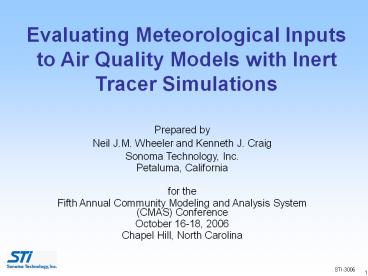Prepared by - PowerPoint PPT Presentation
Title:
Prepared by
Description:
Surface concentrations. Concentration trends (not an evaluation) ... Transport between the SJV, SV, and SFBA air basin occurs on some days but does ... – PowerPoint PPT presentation
Number of Views:27
Avg rating:3.0/5.0
Title: Prepared by
1
Evaluating Meteorological Inputs to Air Quality
Models with Inert Tracer Simulations
Prepared by Neil J.M. Wheeler and Kenneth J.
Craig Sonoma Technology, Inc. Petaluma,
California for the Fifth Annual Community
Modeling and Analysis System (CMAS)
Conference October 16-18, 2006 Chapel Hill, North
Carolina
STI-3006
2
Background
- Wintertime particulate matter (PM)
- Salt Lake and Utah Valleys
- Vertical Transport and Mixing Experiment (VTMX)
- San Joaquin Valley (IMS-95)
- California Regional PM10/PM2.5 Air Quality Study
(CRPAQS) - Readiness of meteorological data and models to
support PM modeling in the SJV
3
The Central Valley of California
4
General Questions
- To what extent can we drive and evaluate
diagnostic/prognostic meteorological models using
the meteorological data collected? (What can we
do with the data?) - Do the simulated meteorology fields represent
reality? (Do the models produce anything useful?)
5
Modeling and Analysis Periods
- CALMET (STI)
- 12/24/2000 12/30/2000
- 01/03/2001 01/09/2001
- MM5 (CARB)
- 12/14/2000 01/08/2001(No FDDA Case)
- Combined
- 12/25/2000 12/30/2000
- 01/03/2001 01/08/2001
6
Tracer Distribution
- Purpose Assess modeling systems behavior
- Method CAMx simulations
- Meteorological processing
- MM5CAMx
- CMETCAMx
- Initial conditions 1 ppm of inert tracer
- Emissions and boundary conditions Zero
- Analysis
- Surface concentrations
- Mass balance
- Peak tracer concentrations by region
7
December Case
7 hours 60 hours
8
January Case
12 hours 55 hours
9
Tracer Animation
10
Summary of Tracer Distribution
- CAMx loses mass faster with CALMET meteorology
than with MM5. - CAMx-MM5 maintains a clearer separation of mass
within the Central Valley. - CALMET is losing mass through vertical transport.
- Evidence of observation-induced divergence is
seen in CALMET, which may be useful for
eliminating unrepresentative sites.
11
Tagged Tracers
- Purpose Analysis of transport differences
- Method CAMx Simulations
- Initial and Boundaries Conditions Zero
- Emissions NOx emissions mapped as unique inert
tracer species to 6 urban areas and 1 all other
area - Analysis
- Surface concentrations
- Concentration trends (not an evaluation)
- Contributions to concentrations at specific sites
12
Tracer Source Areas
- Sacramento
- San Francisco Bay Area
- Stockton- Modesto
- Fresno
- Visalia
- Bakersfield
- Other
13
Angiola
December 25-30, 2000
MM5-CAMx Inert Tracer
CALMET-CAMx Inert Tracer
14
Modesto and Livermore
CALMET MM5
15
Fresno MM5-CAMx
December 18 January 9
16
Urban Tracer Animation
17
Summary of Tagged Tracers
- Local tracer emissions dominate the total tracer
concentration although 5 to 30 of the total
tracer concentrations at the urban sites are from
rural areas - The relative contribution of rural tracers at
urban sites is less in CALMET simulations than in
the MM5 simulations - Transport between the SJV, SV, and SFBA air basin
occurs on some days but does not dominate most of
the analysis period (Inter-basin transport) - The relative contribution of non-local tracers
(i.e., tracers not emitted from the area selected
for analysis) is larger in MM5 than in CALMET
(Intra-basin transport)
18
Conclusions
- We cannot say which system is correct
- CALMET-CAMx predicts greater local contributions
to inert-tracer concentrations but appears to
lose mass too fast from the Central Valley. - MM5-CAMx maintains mass in the Central Valley
longer than CALMET-CAMx but predicts greater
non-local contributions to inert-tracer
concentrations even though it underestimates wind
speeds. - The differences in model results may affect
conclusions about inter- and intra-basin
transport. - The use of inert tracer simulations was found to
be a useful technique in comparing meteorological
models and diagnosing potential problems in the
modeling systems.































